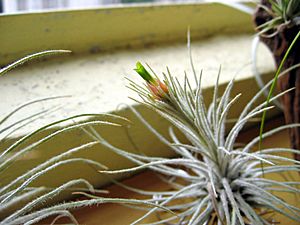Tillandsia plumosa
Quick facts for kids Tillandsia plumosa |
|
|---|---|
 |
|
| Scientific classification | |
| Genus: |
Tillandsia
|
| Species: |
plumosa
|
| Synonyms | |
|
Viridantha plumosa (Baker) Espejo |
|
Tillandsia plumosa is a fascinating type of flowering plant that belongs to the Bromeliaceae family. These plants are often called "air plants" because of how they grow. This specific species is originally from Mexico.
Contents
About Tillandsia Plumosa
Tillandsia plumosa is a unique plant. It's known for its feathery, soft appearance, which is where its name "plumosa" comes from. This plant is not like most others you see in gardens. It doesn't need soil to grow! Instead, it gets all its water and nutrients from the air around it.
Where Does it Live?
This amazing air plant is native to Mexico. You can find it growing in different parts of the country, especially in mountainous regions. It often lives in high-altitude areas where the air is humid. Tillandsia plumosa loves to attach itself to trees or rocks. It uses these surfaces for support, but it doesn't take anything from them. This means it's not a parasite.
How Does it Grow?
Tillandsia plumosa is an epiphyte or a lithophyte. An epiphyte is a plant that grows on another plant, like a tree, but doesn't harm it. A lithophyte is a plant that grows on rocks. These plants have special leaves that are covered in tiny, fuzzy scales called trichomes. These trichomes are like tiny sponges. They help the plant absorb water and nutrients directly from the rain, mist, and dust in the air.
Because it doesn't need soil, Tillandsia plumosa can live in places where other plants can't. It thrives in environments where there's good air circulation and enough humidity. Its roots are mainly for anchoring itself to a surface, not for taking in water.
What Does it Look Like?
Tillandsia plumosa is a beautiful plant. It usually forms a small, dense clump of leaves. The leaves are slender and covered in fine, silvery hairs, giving the plant a soft, fuzzy look. This fuzzy texture is what makes it look "plumosa" or feathery.
When it's ready to bloom, the plant produces a flower stalk. The flowers are often small and can be purple or blue. They are usually hidden among the leaves. After flowering, the plant might produce "pups." These are small baby plants that grow from the base of the parent plant.
Life Cycle and Reproduction
The life cycle of Tillandsia plumosa begins with a seed or a small "pup." If it starts from a seed, the tiny seed needs to find a suitable place to attach itself. Once it's anchored, it slowly grows, absorbing moisture and nutrients from the air.
As the plant matures, it will eventually produce flowers. These flowers are pollinated, often by insects or hummingbirds. After pollination, the plant produces seeds. These seeds are usually feathery, which helps them float on the wind to new locations.
Another common way Tillandsia plumosa reproduces is by making "pups." These pups are genetically identical to the parent plant. They grow at the base of the mature plant. Once they are big enough, they can be gently separated from the parent plant and grown on their own. This allows the plant to spread and create new colonies. The parent plant might slowly die after producing many pups and flowering, but the new pups continue the life cycle.
Caring for Tillandsia Plumosa
Because of their unique beauty and easy care, Tillandsia plumosa and other air plants are popular houseplants. They don't need potting soil, so you can display them in many creative ways. People often place them in glass terrariums, on decorative rocks, or simply hang them.
To care for them, you need to make sure they get enough water. This is usually done by misting them with water a few times a week or by soaking them in water for about 20-30 minutes every one to two weeks. They also need bright, indirect light and good air circulation to stay healthy.
See also
 In Spanish: Tillandsia plumosa para niños
In Spanish: Tillandsia plumosa para niños

